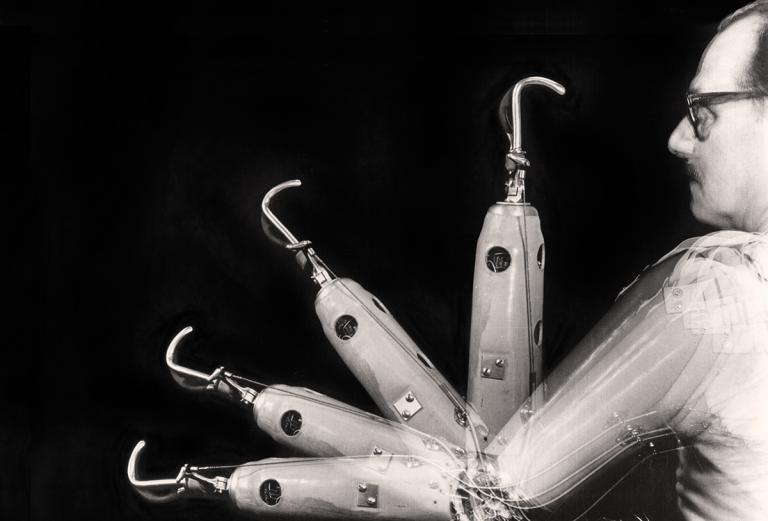The Art of Motion
Melvin Glimcher and the invention of the myoelectric elbow
- Profile

A high-speed, stop-action photo of a patient using the “Boston Arm,” an electric elbow with myoelectric control.
The first time Melvin Glimcher, MD ’50, tried to enlist in the Marines, his mother dragged him out of the recruiting office. He was 17.
His second try succeeded, although not precisely as he had hoped. Instead of being sent to the front lines of World War II, Glimcher was deemed “too smart” for combat and was dispatched to college to study physics and mechanical engineering. A medical degree followed, magna cum laude.
As the field of orthopedics came of age, Glimcher became a pioneer in biomechanics, publishing iconoclastic papers on bone formation, bone structure, and gait. He also collaborated on the development of the first bionic elbow.
Dubbed the Boston Arm, this device changed the lives of upper-limb amputees, including military veterans.
In the late 1950s, Glimcher was spending one day each week at the Liberty Mutual Insurance Company in Boston, treating patients who had lost limbs following workplace accidents. He observed that patients with amputations below the elbow got more use from prosthetic arms than those without the joint. He proposed developing an improved above-elbow prosthesis. The company supported his idea, hoping its fruition would help injured policyholders return to work.
Glimcher flew to the Soviet Union to inspect a myoelectric hand—a prosthesis that used electrical signals from the wearer’s residual muscles to control movement.
Then, in the early 1960s, fate again intervened. Glimcher was serving as an HMS associate professor of orthopedic surgery at Massachusetts General Hospital. One of his patients, admitted with a broken hip, was MIT professor Norbert Wiener, the “father of cybernetics.” Conversations between the two soon became discussions of human-machine interfaces. They started collaborating; others joined their effort, notably MIT’s Robert Mann, a rocket scientist who had shifted focus to alleviating physical disabilities.
In 1968, the team unveiled its prototype for the first above-elbow myoelectric arm.
The Boston Arm activated when the wearer tried to move their missing lower arm. The biceps or triceps muscle in their residual limb generated a faint electrical signal that was amplified by electrodes taped to the skin and sent to a motor inside the prosthesis. The motor, powered by a battery pack worn on a belt, turned a screw that bent or straightened the artificial elbow.
The arm further broke precedent by offering dynamic speed, acceleration, and force. The elbow bent faster if it received a bigger jolt from the biceps, while so-called strain gauges urged the muscles in the residual limb to work harder to lift heavier objects. The prosthesis ended in a hook controlled by hunching the shoulder.
The Boston Arm took minutes to learn instead of the weeks required by contemporary cable-and-harness mechanical arms, which forced wearers to contort their bodies to operate.
News outlets hailed the innovation as Vietnam War veterans streamed home with upper-limb amputations. There was talk of providing Boston Arms to survivors of polio and thalidomide-induced birth defects. Laurie Glimcher, MD ’76, president and CEO of the Dana-Farber Cancer Institute, recalls her father appearing on television and in newspapers.
“He had a willingness to try new things and take big risks, even if there was a chance he’d fail.”
“I think the Boston Arm reflected my dad’s love of discovery and appetite for going in new directions,” she says. “He had a willingness to try new things and take big risks, even if there was a chance he’d fail.”
“What’s the point of living,” she adds, “if you’re not trying something important?”
Melvin Glimcher and colleagues achieved a marketable version of the arm in 1973. The device wasn’t perfect—some users found it heavy, bulky, and noisy—and fewer than a thousand were ultimately sold. More influential than the arm itself, however, were the principles behind its use of natural muscle signals. The concept inspired a generation of myoelectric prostheses.
Stephanie Dutchen is a science writer in the HMS Office of Communications and External Relations.
Image: Courtesy MIT Museum